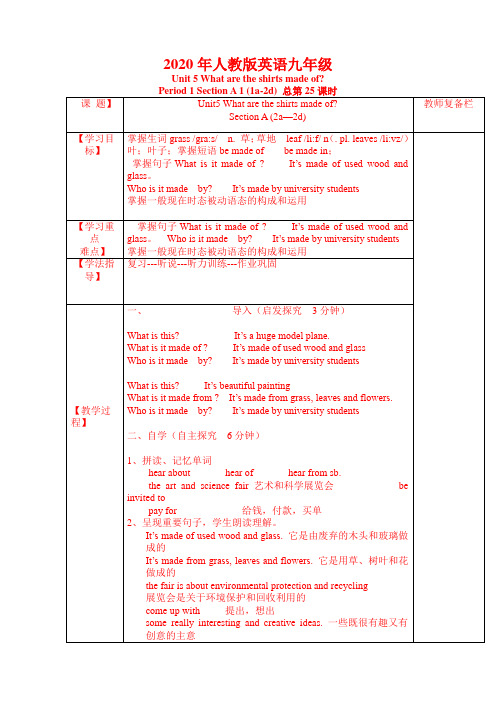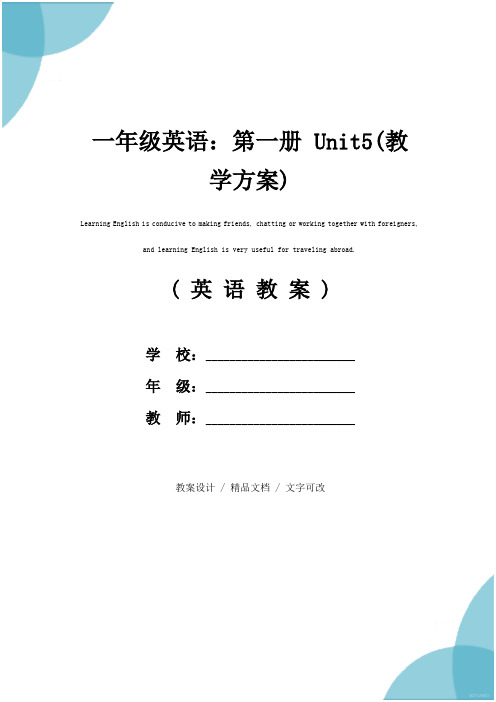Unit5Period1教案
- 格式:doc
- 大小:36.00 KB
- 文档页数:2

五年级上册英语教案Unit 5 Can I have a pet? Period 1 湘少版(三起)教学内容本节课为湘少版五年级上册英语教材Unit 5 Can I have a pet? 的第一课时。
教学内容围绕宠物话题,包括宠物名称、描述宠物的形容词以及询问和表达是否可以养宠物的句型。
课程旨在通过丰富的语言实践活动,让学生掌握与宠物相关的词汇和表达方式,并能就宠物话题进行简单交流。
教学目标1. 知识目标:学生能够听懂、会说、会读本节课的宠物词汇,如“dog”, “cat”, “fish”等,并能运用描述宠物的形容词,如“cute”, “funny”。
2. 能力目标:学生能够在情景对话中正确运用句型“Can I havea pet?”来表达自己想要养宠物的意愿,并能对别人的询问做出回应。
3. 情感目标:培养学生对宠物的喜爱之情,同时教育他们要负责任地对待宠物。
教学难点本节课的教学难点在于正确使用情态动词“can”来询问和表达是否可以做某事,以及如何运用形容词来描述宠物特征。
教具学具准备1. 教材和练习册。
2. 宠物图片和单词卡片。
3. 录音机或音响设备,用于播放教材音频。
4. 黑板和彩色粉笔。
教学过程1. 导入:通过展示宠物图片,引导学生复习已学过的宠物词汇,激发学生对本节课的兴趣。
2. 新授:教授新单词和句型,使用图片和实物辅助教学,确保学生理解并能够正确发音。
3. 练习:设计小组活动,让学生在情景模拟中练习新学到的词汇和句型。
4. 巩固:通过听录音、跟读和角色扮演等活动,巩固学生对新知识点的掌握。
板书设计板书将包括本节课的关键词汇、句型和重要语法点。
使用不同颜色的粉笔突出重点,使板书清晰易懂。
作业设计1. 书面作业:完成练习册上与本节课内容相关的练习题。
2. 口头作业:回家后向家长用英语介绍自己最喜欢的宠物,并说明原因。
课后反思课后反思将围绕学生的参与度、新知识点的掌握程度以及教学方法的有效性进行。

2020年人教版英语九年级Unit 5 What are the shirts made of?Period 2 Section A Section A (3a-3c) 总第26课时一、教学目标:1. 语言知识目标:1) 学习掌握下列词汇:France, no matter, local, brand, avoid, product, handbag,mobile, everyday2)阅读短文,能按要求找到相应的信息。
3)通过阅读提高学生们的阅读能力。
4) 了解“中国制造”已在世界各国广泛存在,并被世界人民所认可。
2. 情感态度价值观目标:通过阅读短文,让学生们明白中国在近代的发展状况,认识到我们伟大的中国正在快速崛起,从以前依赖进口国外工业产品,到中国制造,中国已加入工业大国之列。
二、教学重难点1. 教学重点:1) 掌握本部分出现的生词和词组,达到熟练运用的目标。
2) 阅读短文,获得相关的信息。
通过阅读练习,来提高阅读能力。
2. 教学难点:1) 阅读短文,获得相关的信息的能力。
2) 理解并运用所学的词汇及表达方式。
三、教学过程Ⅰ. Revision1. Ask Ss to role-play the conversation in 2d.2. Check the homework. Let some Ss tell read their sentences.(1). This ring is made of silver.(2). This kind of paper is made from wood.(3). What is paint made from?(4). Hang Zhou is famous for tea.(5). As far as I know, tea plants are grown on the sides of the mountains.Ⅱ. Lead in1. 展示一段伦敦奥运会礼品的视频,让学生了解中国制造已被世界人民所接受。

UNIT 5 Period One题组A 基础练Ⅰ.单词拼写1.Yuan Longping realised that farmers needed to ________(使增长) yields in the fields they had.2.The night before the test I was ________(克服) by fear and despair.3.This hybrid enabled farmers to expand their ________(产量) greatly.4.Given that Yuan's hybrids have made him quite wealthy, one might think he would retire to a life of ________(闲暇).5.As a man of the soil, he cares little for ________(名誉) or money.6.(全国卷Ⅱ)According to the World Bank, China accounts for about 30 percent of total global fertilizer ________(消耗量).7.The country's present difficulties arise out of the ________(缺乏) of petroleum(石油) .8.The first reason to ________(应对) these problems is to save children's lives.9.One ________(特点) I have observed over the years in all great software developers is their passion for their work.10.I don't think there's enough information to make an ________(假设).【答案】1.boost 2.overcome 3.output 4.leisure5.celebrity 6.consumption 7.shortage 8.tackle9.characteristic 10.assumptionⅡ.单句语法填空1.A year ________(comprise) of the four seasons of spring, summer, autumn and winter.2.________ is estimated that 1.3 billion people will use English as either a first or a second language by .3.It never occurred to me that you could succeed in ________(persuade) him to change his mind.4.In our school, most of our students ________(attain) five “A” grades in their epressed me most is the optimistic attitude of the disabled.6.________(give) that he can get another chance, he will surely succeed.7.After ________(graduate) from college, he went to the United States for further study.8.The company, New England Electric, burns coal ________(generate) power.9.This argument seems ________(convince), but is easily overturned.10.Steve was ________(intense) curious about the world I came from.【答案】1.is comprised 2.It 3.persuading 4.attained5.What 6.Given 7.graduating 8.to generate9.convincing 10.intensely题组B 提升练Ⅰ.阅读理解“Peop le still want plastic bottles, because they reseal and are lightweight,” said Ms Perez, Coca Cola's head of sustainability.The firm, which is one of the biggest producers of plastic waste, has claimed to use at least 50% recycled material in its packaging by .But environmental campaigners argue many Coke bottles would still go uncollected and end up in landfill. Elsewhere, plastic were clogging up (堵塞)the seas, harming marine life.The drinks giant produces about three million tonnes of plastic packaging a year - equivalent to 200,000 bottles a minute. In , it was found to be the most polluting brand in a global audit (调查)of plastic waste.But speaking at the World Economic Forum in Davos, Ms Perez said the firm recognized it now had to be part of the solution.However, Ms Perez said the firm could not ditch plastic outright, as some campaigners wanted, saying this could hit sales. She also said using only aluminum and glass packaging could push up the firm's carbon footprint. “Business won't be in business if we don't accommodate consumers,” she added. “So as we change our bottling infrastructure, move into recycling and innovate, we also have shown the consumer what the opportunities are. They will change with us.”Ms Perez said she respected the idealism of youth activists and also agreed with calls for Coca Cola to reach its environmentalgoals sooner than -although she would not say whether she would step down if the plans failed.1.According to the text, what bad effects do plastic bottles have?A.It is impossible to recycle plastic.B.Plastic debris causes damage.C.Plastic is seen as the most polluting material.D.Plastic production leads to higher carbon footprint.2.What does the underlined word “ditch” in Paragraph 6 mean?A.give out B.give upC.change D.doubt3.What can we infer from Perez's words in Paragraph 6?A.Coca Cola balances their needs with those of customers.B.The question remains whether nonplastic bottles will affect market.C.The firm creates whatever customers need.D.Campaigners urge Coca Cola to solve the problem step by step.【语篇解读】本文是一篇议论文,介绍了作为最大塑料制品之一的生产公司——可口可乐公司在环保人士的呼吁下,企图在满足消费者需求与达到环保目标之间寻找一个平衡点。

Unit 5Do you have a soccer ball?Period 1 Section A (1a~1c)教学准备:1.教师:准备多媒体课件,搜集一些球类及球拍的图片,收集课文中所涉及的或学生常见的球类运动器材或有关的教学幻灯片或图片;制作1a 部分的插图和人物对话的课件,将听力部分的内容插入,通过询间对方的所属以及回答来引入新课,以及与球类有关的故事。
2.学生:搜集自己所了解的或曾经见过的球类运动器材的名称,并通过询问老师、同学或上网查询的方式了解有关球类的历史故事。
教材分析:通过uint4 单元询问物品在哪的学习,过渡到本单元谈论物品的所属关系,而本单元的核心语言项目是talk about ownership,展开学习;以及围绕make suggestions 展开能力训练。
主要话题是spending time with friends,培养同学间团结、友爱的精神。
学会使用have 对物品的所属进行提问及回答,以掌握行为动词在一般现在时中的构成和使用;同时引导学生使用所学的句型谈论自己在球类运动中的喜好,以及谈论自己对某项运动的感受等。
本部分1a1c通过图文及听力练习导入整个单元的话题,是整个Section A 的基础。
学情分析:本单元的主题是使用have对物品的所属进行提问及回答,以掌握行为动词在一般现在时中的构成和使用:同时引导学生使用所学的句型谈论自己在球类运动中的喜好。
行为动词在一般现在时的肯定句、否定句和一般疑问句中的构成和使用是初中英语教学中非常重要的内容,七年级的学生经过小学的学习后。
已经具备了一定的英语语言功底,在思雄能力方面有较强的记忆力和模仿力,但知识的扩展和运用能力有待于进一步提高,在认知心理方面,学生有较强的求知欲和表现欲。
并初步具备了合作探究能力。
核心素养:1.语言能力:Control key vocabularies such as tennis, soccer, ball, volleyball, basketball, pingpong and key sentences: Do you have...?Yes. I do. /No. I don't.2.学习能力:Ask and answer questions about the ownership.Train the students' municative petence and listening skill.3.思维品质:After learning these sport words, students can use them in real life and love doing sports.4.文化意识:Do sports every day and keep healthy.Teaching important points1.Key words & phrases:do,have,tennis,ball,ping-pong,bat,soccer,soccer ball,volleyball,basketball2.Key sentences:Do you have a ping-pong bat?Yes,I do.Do you have a ping-pong ball?No,I don't.Teaching difficult pointsBe able to use the word “have” properly.Teaching aidsPPT,pictures,a tape player,objectsTeaching procedures and ways★Step Ⅰ Lead-inLet’s enjoy a videosports song.Ask a question: How many kinds of sports are there in the video?T:Today,let's study Unit 5.★Step Ⅱ Presentation1.Show students a soccer ball and ask:T:What's this?Ss:It is a soccer ball.T:Yes,listen,soccer ball(read the word three times).I have a soccer ball.Do you have a soccer ball?S1:Yes…S2:No…S3:No…(Write down the title on the blackboard.)Then learn and read other new words and phrases(Write down these words and phrases on the blackboard.)2.Game: quick eyes and have a challenge of matching these words and pictures.After that work on 1a.★Step Ⅲ Cooperative inquiry1.Listening (1b)Listen and circle the words in the box.2.Listen again and repeat.3.PracticePractice the conversation in 1c with your partner and then make up your own conversations with picture.4 Ask and answer5 .Pair work★Step Ⅳ SummaryReview the words and sentences and tell the students : Sports make us healthy. Let’s do sports together.★StepⅤ Homework1.Write some sports things you have.2. Interview your friends and parents with the following sentence patterns:Do you have .......?Yes, I do. I have a...No, I don't . I don't have a...Blackboard writingTeaching reflection本单元的教学重点是学会动词have的一般现在时的肯定陈述句、否定句和一般疑问句。

( 英语教案 )学校:_________________________年级:_________________________教师:_________________________教案设计 / 精品文档 / 文字可改一年级英语:第一册 Unit5(教学方案)Learning English is conducive to making friends, chatting or working together with foreigners, and learning English is very useful for traveling abroad.一年级英语:第一册 Unit5(教学方案)Teaching Plan of Fun with English 3AUnit 5 How are you?(Period 1)l Teaching content:Unit 5 How are you?l Teaching targets:1. Aim of knowledge:Pupils are able to read and speak out drills: How are you? Fine, thank you. And you?Not bad, thank you. Not so good. I’m sorry.2. Aim of ability:Pupils are able to inquire someone’s health.3. Aim of emotion:Pupils are interested in singing : Goodbyel Focal points:Drills: How are you? Fine, thank you. And you?Not bad, thank you. Not so good. I’m sorry.l Difficult points:Answer one’s inquiring according one’s own status.l Teaching aids:Tape cassette, recorderl Teaching steps:Step 1. SingingSing a song: GoodbyeStep 2 Presentation(T) Hello, boys and girls, how are you today?(Ss) Fine, thank you. And you?(T) Not bad, thank you.(S1) Hello, Miss Yang. How are you?(T) (pretend to catch a cold)Not so good.(T Ss) I’m sorry.Step 3 Practice(T) How are you today?(S1) Fine, thank you. /Not bad, thank you. / Not so good. Step 4 Listening& Reading(Ss) Read after the tape , then read after the teacher Read togetherDesign of writingUnit 5 How are you?How are you?Fine, thank you./ Not bad, thank you. / Not so good. Teaching Plan of Fun with English 3AUnit 5 How are you?(Period 2)l Teaching content:Unit 5 How are you?l Teaching targets:1. Aim of knowledge:Pupils are able to read and speak out new words: pencils, pens, rulers, pencil boxes, ball pens, pencil sharpeners, rubbers, books2. Aim of ability:Pupils are able to get idea about plural forms.3. Aim of emotion:Pupils are interested in asking and answering about their own stationaries.l Focal points:Words of plural forms: pencils, pens, rulers, pencil boxes, ball pens, pencil sharpeners, rubbers, booksl Difficult points:Correct pronunciation of plural forms.Teaching aids:Tape cassette, recorder, some pictures.l Teaching steps:Step 1 Free talk:How are you?Fine, thank you. And you? Not bad, thank you. Not so good.I’m sorry.Step 2 Presentation(T) ( Present a pen) What’s this?( Present two pens) What are these?( Read: pens)(Same method as teaching : pencils, rulers, pencil boxes, ball pens, pencil sharpeners, rubbers, books)Step 3 Practice(Ss) Ask and answer about one’s stationary.Step 4 A game( Guess and say) ( Touch and say)Step 6 Listen and circleDesign of WritingUnit 5 How are you?Teaching Plan of Fun with English 3AUnit 5 How are you?(Period 3)l Teaching content:Unit 5 How are you? (period 3)l Teaching targets:1. Aim of knowledge:Revise words: pencils, pens, rulers, pencil boxes, ball pens, pencil sharpeners, rubbers, books and drills: How are you? Fine, thank you. And you?Not bad, thank you. Not so good.I’m sorry.2. Aim of ability:Pupils are able to get idea about plural forms.3. Aim of emotion:Pupils are interested in asking and answering about their own stationaries.l Focal points:Exercises of Unit 5l Difficult points:Correct pronunciation of plural forms.l Teaching aids:Tape cassette, recorder, some stationary.l Teaching steps:Step 1 SingingHello! How are you?Step 2 Presentation1. Listen and respond2. Listen and colour3. Listen and drawStep 3 Practice(Ss) Ask and answer about stationary.Step 4 A game( Guess and say) ( Touch and say)Step 5 Listen and circleHomework1. Read Unit 5.2. Copy the letters.教学后记:Not so good. 和Not bad有个别学生搞不清楚,容易混淆,在接下来的每日英语中要多加练习。

新人教PEP版小学四年级英语下册Unit 5优质教案Period 1Part A Let’s talk,Let’s play本课时是第五单元的第一课时,主要学习Let’s talk和Let’s play两个环节。
Let’s talk通过体育课结束后老师和埃米的对话呈现了本课时重点句型“—Are these/those(+可数名词复数) +名词所有格/名词性物主代词? —Yes, they are./No, they aren’t.”“主语+be动词(am/is/are)+名词性物主代词/名词所有格.”“—Is this/that+名词所有格/名词性物主代词?—Yes, it is./No, it isn’t.”让学生感受其语义及语用情景。
Let’s play为一个活动,要求学生把学习用品、衣物等放在一起,然后讨论其归属,从而巩固Let’s talk所学重点句型。
知识目标1.能够听、说、认读三会单词:hat;2.能够听、说二会单词:yours;3.能够用句型“—Are these/those(+可数名词复数)+名词所有格/名词性物主代词? —Yes, they are./No, they aren’t.”询问某些物品是否属于某人并作答;4.能够用句型“主语+be动词(am/is/are)+名词性物主代词/名词所有格.”描述某物属于某人;5.能够用句型“—Is this/that+名词所有格/名词性物主代词? —Yes, it is./No, it isn’t.”询问某个物品是否属于某人并作答;6.能够理解Let’s talk的对话内容并分角色表演对话。
能力目标培养学生的口语表达能力和交际能力。
情感目标培养学生拾金不昧,主动归还物品的优良品德。
教学重点1.能够用句型“—Are these/those(+可数名词复数)+名词所有格/名词性物主代词?—Yes, they are./No, they aren’t.”询问某些物品是否属于某人并作答;2.能够用句型“主语+be动词(am/is/are)+名词性物主代词/名词所有格.”描述某物属于某人;3.能够用句型“—Is this/that+名词所有格/名词性物主代词?—Yes, it is./No, it isn’t.”询问某个物品是否属于某人并作答。
译林版七年级上册Unit 5“A healthy lifestyle”Period 1 “Welcome to the unit”说课稿尊敬的各位评委、老师:大家好!今天我说课的内容是译林版七年级上册Unit 5“A healthy lifestyle”的第一课时“Welcome to the unit”。
下面我将从教材分析、学情分析、教学目标、教学重难点、教学方法、教学过程以及教学反思这几个方面来展开我的说课。
一、教材分析本单元的主题是“健康的生活方式”,围绕这一主题展开了一系列与健康生活相关的话题和活动。
“Welcome to the unit”部分作为单元的导入,通过图片和简单的对话,引出了关于健康生活习惯和不健康生活习惯的讨论,为后续的学习奠定了基础。
这部分教材内容生动有趣,贴近学生的生活实际,能够激发学生的学习兴趣和积极性。
同时,也为学生提供了丰富的语言输入和语言实践的机会,有助于培养学生的语言综合运用能力。
二、学情分析七年级的学生正处于身心发展的关键时期,他们对新鲜事物充满好奇心,具有较强的模仿能力和表现欲望。
在经过了一段时间的英语学习后,他们已经具备了一定的英语基础知识和语言技能,能够进行简单的日常交流。
然而,他们的自主学习能力和思维能力还有待提高,需要教师在教学过程中给予适当的引导和启发。
三、教学目标基于对教材和学情的分析,我制定了以下教学目标:(一)知识目标1. 学生能够掌握本课时的重点词汇,如:lifestyle, health, hamburger, cola, lemonade, chocolate, watermelon 等。
2. 学生能够理解并运用有关健康生活和不健康生活的表达方式,如:A healthy lifestyle is important. Eating too much hamburgers is bad for our health. 等。
(二)能力目标1. 能够听懂关于健康生活和不健康生活的简单对话,并获取关键信息。
译林版(三起)六年级上册英语教案:Unit5 signs(Period 1)一、教学目标1. 知识与技能:(1)能够正确听、说、读、写单词sign、traffic、cross、stop、wait、signboard、sir、promise、rule。
(2)能够理解并在适当的情境中运用句型There are sometraffic signs./These are/They tell us/We must。
(3)能够理解并在适当的情境中运用情态动词must和don'thave to。
2. 过程与方法:(1)通过图片、情景创设等方式,培养学生英语听说能力。
(2)通过小组合作、角色扮演等活动,提高学生的英语交际能力。
3. 情感态度与价值观:(1)培养学生遵守交通规则的意识。
(2)培养学生合作、分享的良好品质。
二、教学内容1. 单词:sign、traffic、cross、stop、wait、signboard、sir、promise、rule。
2. 句型:There are some traffic signs./These are/Theytell us/We must。
3. 情态动词:must和don't have to。
三、教学重点与难点1. 教学重点:(1)正确运用单词sign、traffic、cross、stop、wait、signboard、sir、promise、rule。
(2)运用句型There are some traffic signs./These are/They tell us/We must。
(3)理解并运用情态动词must和don't have to。
2. 教学难点:(1)单词的记忆与运用。
(2)句型的正确运用及实际情境中的运用。
(3)情态动词must和don't have to的区分与运用。
四、教具与学具准备1. 教具:多媒体课件、图片、卡片、黑板。
教学设计
Unit 5 Do you want to watch a game show ?
Period 1(1a-2d)
泗县中学朱家标
一、教材分析:
本节课为人教版Go for it!新目标八上册年英语教材第5单元的一节对话课。
本单元的话题是“Talk about preferences ; Make plans ”。
围绕这一话题我采用调查,了解,和采访等方式让同学们通过参与来激发学习兴趣进而加强对知识的理解并能达到灵活运用的能力。
让学生学会询问对方并了解别人喜好和计划,以便于今后在交际中恰当表达自己的情感,并学会恰当正确地谈论这一话题。
二、教学目标:
1.能够熟记有关电视节目的词汇。
talk show soap opera sports show sitcom
game show talent show news
2.学会使用电视节目的词汇来询问或表达想法。
三、教学重点:学生能熟记相关的词组和句式。
四、教学难点:掌握并能正确理解相关句式,并能进行这一话题的
正确谈论。
五、教法:合作学习为主。
六、学法:小组合作学习法、自主学习法、观察法等。
七、模式:感知体会----语言实践—综合运用
八、教学过程:
Step1情境导入
以歌曲导入,激发了学生的兴趣,对本课学习内容有所期待。
同时歌曲也是当下比较流行的,拉近与学生间的学习距离。
a. 出示目标,明确目标。
Step2完成目标A : 感知体会------读,听为主,感知体会并模仿
a . 首先是熟记单词,采取提高注意力和瞬间记忆力的方式来记忆单词的顺序。
这样学生能够更有兴趣,然后采取比赛的形式来记忆巩固已记单词。
b. 突破重点
本节课的重点是talk about preferences 的对话练习,并能达到熟练的程度。
利用刚才练习的单词进行对话后给学生时间组内练习。
根据实际情况对教材进行重新组合,整体感知,为了下一步的语言实践奠定基础,提高课堂效率。
1.让同学熟读1c ,2c , 2d ,然后完成相关问题。
2.组内练习。
教师指导,巡视。
3.展示汇报。
4.根据学生掌握情况适当进行随机练习。
Step3 攻破难点。
完成目标B : 语言实践---所学语言在实际中应用1.利用刚才掌握的句式进行练习。
首先是师生对话,教师示范如何
问,如何记录。
也是由说语言到用语言写语言的过程。
2.教师点拨。
教师让学生上黑板写重点句子,然后大家一起观察这些句子,把机会留给学生,让他们去观察发现语言的规律及特点,这样学生更有兴趣同时自己发现的也更容易理解和记忆。
3.根据教师点拨是示范水到渠成地来达成第二个目标,让同学们能
够很容易自编对话。
4. 展示对话。
Step 4. 趁热打铁,综合运用,检测本节课所学。
Step 5 . 家庭作业。
了解家人的喜好,然后做一个调查表,在课上和同学们交流。